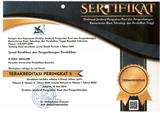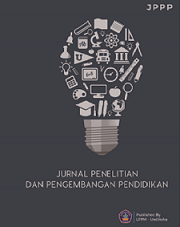Teaching Materials for Reading in a Professional Context to Improve the Reading Skills of English Education Program Students
DOI:
https://doi.org/10.23887/jppp.v8i1.65693Keywords:
English, Teaching Materials, Reading SkillsAbstract
Students expressed difficulty in dealing with unfamiliar vocabulary and complex sentence structures, which hindered their ability to identify important information and understand the message conveyed in the text. This research aims to develop a teaching tool called Reading for Professional Context that is appropriate to the cultural environment to improve the reading skills of students majoring in English education. This type of research is developed with a research design using the Graves model. The research subjects were two subject matter experts, two teaching materials experts, and two language experts. The trial subjects involved 22 students. Data collection methods use observation, interviews, and questionnaires. Data collection instruments with questionnaire sheets. Data analysis techniques use qualitative and quantitative analysis. The linear regression test is used to see the effect of teaching materials on reading skills. The results, namely the expert assessment, show that the product has excellent qualifications. The results of the linear regression test show that the use of "Reading for Professional Context" teaching materials significantly positively influences students' reading skills. It was concluded that the "Reading for Professional Context" teaching materials could improve students' reading skills. The findings from this research provide valuable insights for English language educators and curriculum developers in designing effective reading teaching materials to improve students' abilities in professional contexts.
References
A. Al Roomy, M. (2022). Investigating the Effects of Critical Reading Skills on Students’ Reading Comprehension. Arab World English Journal, 13(1), 366–381. https://doi.org/10.24093/awej/vol13no1.24. DOI: https://doi.org/10.24093/awej/vol13no1.24
Abdelrady, A. H., Jahara, S. F., Elmadani, A. E. A., & Kumar, T. (2022). The Attitude of Sudanese EFL Students towards Literature to Enrich Their Vocabulary Building. Education Research International, 2022(January), 1–12. https://doi.org/10.1155/2022/7569371. DOI: https://doi.org/10.1155/2022/7569371
Abeer M. W. Alharbi. (2022). Reading skills among EFL learners in Saudi Arabia: A review of challenges and solutions. World Journal of Advanced Research and Reviews, 15(3), 204–208. https://doi.org/10.30574/wjarr.2022.15.3.0922. DOI: https://doi.org/10.30574/wjarr.2022.15.3.0922
Abidin, R., Suryani, N., & Sariyatun, . (2020). Students’ Perceptions of 360 Degree Virtual Tour-Based Historical Learning About The Cultural Heritage Area of The Kapitan and Al-Munawar Villages in Palembang City. International Journal of Social Sciences and Management. https://doi.org/10.3126/ijssm.v7i3.29764. DOI: https://doi.org/10.3126/ijssm.v7i3.29764
Al-Jarf, P. R. (2022). Developing Students’ Global Awareness in EFL Reading and Speaking. South Asian Research Journal of Arts, Language and Literature, 4(1), 31–38. https://doi.org/10.36346/sarjall.2022.v04i01.005. DOI: https://doi.org/10.36346/sarjall.2022.v04i01.005
Al-Noori, B. S. (2019). Teaching English Through Humor And Jokes.pdf. International Journal of Advancement in Social Science and Humanity, 2019(8), 52–57.
Alamri, H., Lowell, V., Watson, W., & Watson, S. L. (2020). Using personalized learning as an instructional approach to motivate learners in online higher education: Learner self-determination and intrinsic motivation. Journal of Research on Technology in Education, 52(3), 322–352. DOI: https://doi.org/10.1080/15391523.2020.1728449
Albiladi, W. S. (2018). Exploring the Use of Written Authentic Materials in ESL Reading Classes: Benefits and Challenges. English Language Teaching, 12(1), 67. https://doi.org/10.5539/elt.v12n1p67. DOI: https://doi.org/10.5539/elt.v12n1p67
Alneyadi, S., Abulibdeh, E., & Wardat, Y. (2023). The Impact of Digital Environment vs. Traditional Method on Literacy Skills; Reading and Writing of Emirati Fourth Graders. Sustainability (Switzerland), 15(4), 1–15. https://doi.org/10.3390/su15043418. DOI: https://doi.org/10.3390/su15043418
Arayaphan, W., Sirasakmol, O., Nadee, W., & Puritat, K. (2022). Enhancing Intrinsic Motivation of Librarian Students using Virtual Reality for Education in the Context of Culture Heritage Museums. TEM Journal, 11(2), 620–630. https://doi.org/10.18421/TEM112-16. DOI: https://doi.org/10.18421/TEM112-16
Arief, Y. Al. (2023). The Use of Linguistic jokes in EFL Classroom. JETAL: Journal of English Teaching & Applied Linguistics, 2(4), 75–82. DOI: https://doi.org/10.36655/jetal.v4i2.1000
Asmara, R. (2021). The Implementation Of Extensive Reading Using Line Webtoon To Enhance Students ’ Reading Comprehension In Narrative Story Rizki Amalia Asmara Abstrak. RETAIN (Research on English Language Teaching in Indonesia), 09(02), 75–82.
Azizah, N., Inderawati, R., & Vianty, M. (2021). Developing descriptive reading materials in efl classes by utilizing the local culture. Studies in English Language and Education, 8(2), 596–621. https://doi.org/10.24815/siele.v8i2.18562. DOI: https://doi.org/10.24815/siele.v8i2.18562
Azizi, Z., Namaziandost, E., & Rezai, A. (2022). Potential of podcasting and blogging in cultivating Iranian advanced EFL learners’ reading comprehension. Heliyon, 8(5), e09473. https://doi.org/10.1016/j.heliyon.2022.e09473. DOI: https://doi.org/10.1016/j.heliyon.2022.e09473
Bakar, F., & Kumar, V. (2022). How students perceive the teacher’s use of humour and how it enhances learning in the classroom. European Journal of Humour Research, 10(4), 187–199. https://doi.org/10.7592/EJHR2022.10.4.656. DOI: https://doi.org/10.7592/EJHR.2022.10.4.656
Bolton, K., Hill, C., Bacon-Shone, J., & Peyronnin, K. (2023). EMI (English-medium instruction) in Indonesian higher education. World Englishes, 42(January), 1–23. https://doi.org/10.1111/weng.12622. DOI: https://doi.org/10.1111/weng.12622
Cates, D. M., Traxler, M. J., & Corina, D. P. (2022). Predictors of reading comprehension in deaf and hearing bilinguals. In Applied Psycholinguistics (Vol 43, Number 1). https://doi.org/10.1017/S0142716421000412. DOI: https://doi.org/10.1017/S0142716421000412
Chen, C. H., Koong, C. S., & Liao, C. (2022). Influences of Integrating Dynamic Assessment into a Speech Recognition Learning Design to Support Students’ English Speaking Skills, Learning Anxiety and Cognitive Load. Educational Technology and Society, 25(1), 01–14.
De Costa, P. I., Gajasinghe, K., Ojha, L. P., & Rabie–Ahmed, A. (2022). Bridging the Researcher–Practitioner Divide Through Community-Engaged Action Research: A Collaborative Autoethnographic Exploration. Modern Language Journal, 106(3), 547–563. https://doi.org/10.1111/modl.12796. DOI: https://doi.org/10.1111/modl.12796
Ebadi, S., & Ashrafabadi, F. (2022). An exploration into the impact of augmented reality on EFL learners’ Reading comprehension. Education and Information Technologies, 27(7), 9745–9765. https://doi.org/10.1007/s10639-022-11021-8. DOI: https://doi.org/10.1007/s10639-022-11021-8
Elmedina Nikoçeviq-Kurti. (2022). European Journal of Educational Research. European Journal of Educational Research, 11(3), 1245–1257. DOI: https://doi.org/10.12973/eu-jer.11.3.1245
Erya, W. I., & Pustika, R. (2021). Students’ Perception Towards the Use of Webtoon to Improve Reading Comprehension Skill. Journal of English Language Teaching and Learning (JELTL), 2(1), 51–56. DOI: https://doi.org/10.33365/jeltl.v2i1.762
Fahmi, R., Friatin, L. Y., & Irianti, L. (2020). THE USE OF FLIPPED CLASSROOM MODEL IN READING COMPREHENSION. JALL (Journal of Applied Linguistics and Literacy), 4(1), 1–18.
Farnia, M., & Karimi, K. (2019). Humor markers in computer mediated communication: Emotion perception and response. Teaching English with Technology, 19(1), 21–35.
Firman, H., & Haramain, M. (2022). Developing the Indonesian student’s personality through recognizing local culture and literature: A brief study of Bugis pappaseng. Journal of Positive School Psychology, 6(8), 6509–6519.
Fitria. (2022). Using Authentic Material and Created Material (Teacher-Made) for English Language Teaching (ELT): Benefits and Limitations. JADEs Journal of Academia in English Education, 3(2), 117–140. https://doi.org/10.32505/jades.v3i2.4674. DOI: https://doi.org/10.32505/jades.v3i2.4674
Goldenberg, C. (2020). Reading Wars, Reading Science, and English Learners. Reading Research Quarterly, 55(S1), S131–S144. https://doi.org/10.1002/rrq.340. DOI: https://doi.org/10.1002/rrq.340
Gong, Y. F., Lai, C., & Gao, X. A. (2022). Language teachers’ identity in teaching intercultural communicative competence. Language, Culture and Curriculum, 35(2), 134–150. https://doi.org/10.1080/07908318.2021.1954938. DOI: https://doi.org/10.1080/07908318.2021.1954938
Habibi, A., Jupri, & Dehghani, S. (2022). Developing the Prototype of Text-Based Learning Materials for the Teaching of Reading Skills at the Middle Schools. Journal of Language and Literature Studies, 2(2), 75–87. https://doi.org/10.36312/jolls.v2i2.760. DOI: https://doi.org/10.36312/jolls.v2i2.760
Hadianto, D., S. Damaianti, V., Mulyati, Y., & Sastromiharjo, A. (2022). Effectiveness of Literacy Teaching Design Integrating Local Culture Discourse and Activities to Enhance Reading Skills. Cogent Education, 9(1), 1–13. https://doi.org/10.1080/2331186X.2021.2016040. DOI: https://doi.org/10.1080/2331186X.2021.2016040
Hanes, L., & Stone, R. (2019). A model of heritage content to support the design and analysis of video games for history education. Journal of Computers in Education, 6(4), 587–612. https://doi.org/10.1007/s40692-018-0120-2. DOI: https://doi.org/10.1007/s40692-018-0120-2
Hartati, A. D., Maryanti, R., Azizah, N. N., Fitria, D., Husaeni, A., Wulandary, V., & Irawan, A. R. (2023). Webtoon Comic Media to Improve Reading Comprehensions for Students with Hearing Impairment in Special Primary Schools ASEAN Journal of Community and Special Needs Education. ASEAN Journal of Community and Special Needs Education, 2(1), 9–16.
Hromova, N., Kryvych, M., Chernihivska, N., Vinnytska, T., & Bloshchynskyi, I. (2022). Forming Critical Reading Skills in a Low-Intermediate Class of English. World Journal of English Language, 12(1), 74–82. https://doi.org/10.5430/WJEL.V12N1P74. DOI: https://doi.org/10.5430/wjel.v12n1p74
Isaqjon Madolimovich, T. (2022). Strategies and techniques for improving EFL learners’ reading skills. Involta" Innovation Scientific Journal, 1(11), 94–99.
Jao, C. Y., Yeh, H. C., Huang, W. R., & Chen, N. S. (2022). Using video dubbing to foster college students’ English-speaking ability. Computer Assisted Language Learning, 35(June), 1–23. https://doi.org/10.1080/09588221.2022.2049824. DOI: https://doi.org/10.1080/09588221.2022.2049824
Kawinkoonlasate, P. (2019). Integration in Flipped Classroom Technology Approach to Develop English Language Skills of Thai EFL Learners. English Language Teaching, 12(11), 23–34. https://doi.org/10.5539/elt.v12n11p23. DOI: https://doi.org/10.5539/elt.v12n11p23
Kim, D. (2020). Learning Language, Learning Culture: Teaching Language to the Whole Student. ECNU Review of Education, 3(3), 519–541. https://doi.org/10.1177/2096531120936693. DOI: https://doi.org/10.1177/2096531120936693
Kristiawan, D., Ferdiansyah, S., & Picard, M. (2022). Promoting Vocabulary Building, Learning Motivation, and Cultural Identity Representation through Digital Storytelling for Young Indonesian Learners of English as a Foreign Language. Iranian Journal of Language Teaching Research, 10(1), 19–36. https://doi.org/10.30466/ijltr.2022.121120.
Kumar, T. (2021). ‘Desire to learn, learn to shine’: Idolizing motivation in enhancing speaking skill among L2 learners. Cypriot Journal of Educational Sciences, 16(1), 411–422. https://doi.org/10.18844/cjes.v16i1.5542. DOI: https://doi.org/10.18844/cjes.v16i1.5542
Kuperman, V., Siegelman, N., Schroeder, S., Acartürk, C., Alexeeva, S., Amenta, S., Bertram, R., Bonandrini, R., Brysbaert, M., Chernova, D., Da Fonseca, S. M., Dirix, N., Duyck, W., Fella, A., Frost, R., Gattei, C. A., Kalaitzi, A., Lõo, K., Marelli, M., … Usal, K. A. (2022). Text reading in English as a second language: Evidence from the Multilingual Eye-Movements Corpus. In Studies in Second Language Acquisition. https://doi.org/10.1017/S0272263121000954. DOI: https://doi.org/10.1017/S0272263121000954
Le, X. M., & Le, T. T. (2022). Factors Affecting Students’ Attitudes towards Learning English as a Foreign Language in a Tertiary Institution of Vietnam. International Journal of TESOL & Education, 2(2), 168–185. https://doi.org/10.54855/ijte.22229. DOI: https://doi.org/10.54855/ijte.22229
Lee, J. F. K., & Li, X. (2020). Cultural representation in English language textbooks: a comparison of textbooks used in mainland China and Hong Kong. Pedagogy, Culture and Society, 28(4), 605–623. https://doi.org/10.1080/14681366.2019.1681495. DOI: https://doi.org/10.1080/14681366.2019.1681495
Mekuo, H. (2023). Using Comic Strips As Teaching Materials In Group Work To Improve Reading Comprehension Of Ninth-Grade Students. Seaqil Journal of Language Education, 2(1), 30–41.
Mubarok, T. A., & Rofi, S. (2022). Problems in learning English of non-English department students. 6(2), 161–166. DOI: https://doi.org/10.31940/jasl.v6i2.335
Murti. (2020). Development of Educational Comic with Local Wisdom to Foster Morality of Elementary School Students: A Need Analysis. International Journal of Educational Methodology, 6(2), 337–343. https://doi.org/10.12973/ijem.6.2.337. DOI: https://doi.org/10.12973/ijem.6.2.337
Neff, P., & Dewaele, J. M. (2022). Humor strategies in the foreign language class. Innovation in Language Learning and Teaching, June, 1–13. https://doi.org/10.1080/17501229.2022.2088761 DOI: https://doi.org/10.1080/17501229.2022.2088761
Octaberlina. (2019). The Use of Humor Story in Improving the Students’ Reading Comprehension. Education, 1(1), 16.
Onishchuk, I., Ikonnikova, M., Antonenko, T., Kharchenko, I., Shestakova, S., Kuzmenko, N., & Maksymchuk, B. (2020). Characteristics of Foreign Language Education in Foreign Countries and Ways of Applying Foreign Experience in Pedagogical Universities of Ukraine. Revista Romaneasca pentru Educatie Multidimensionala, 12(3), 44–65. https://doi.org/10.18662/rrem/12.3/308. DOI: https://doi.org/10.18662/rrem/12.3/308
Putera Jaya, H., Petrus, I., & Lingga Pitaloka, N. (2022). Speaking Performance and Problems Faced by English Major Students at a University in South Sumatra. South Sumatera. Indonesian EFL Journal, 8(1), 105–112.
Raccanello, D., Florit, E., Brondino, M., Rodà, A., & Mason, L. (2022). Control and value appraisals and online multiple-text comprehension in primary school: The mediating role of boredom and the moderating role of word-reading fluency. British Journal of Educational Psychology, 92(1), 258–279. https://doi.org/10.1111/bjep.12448. DOI: https://doi.org/10.1111/bjep.12448
Ristika, N. P. R., Ratminingsih, N. M., & Pratiwi, N. P. A. (2020). A Study of the Instructional Media Used by the English Teachers in Teaching English. Jurnal Penelitian dan Pengembangan Pendidikan, 4(3), 506. https://doi.org/10.23887/jppp.v4i3.27095. DOI: https://doi.org/10.23887/jppp.v4i3.27095
Ritonga, M., Tazik, K., Omar, A., & Saberi Dehkordi, E. (2022). Assessment and language improvement: the effect of peer assessment (PA) on reading comprehension, reading motivation, and vocabulary learning among EFL learners. Language Testing in Asia, 12(1). https://doi.org/10.1186/s40468-022-00188-z DOI: https://doi.org/10.1186/s40468-022-00188-z
Rogers, A., Gardner, M., & Augenstein, I. (2023). QA Dataset Explosion: A Taxonomy of NLP Resources for Question Answering and Reading Comprehension. ACM Computing Surveys, 55(10), 1–40. https://doi.org/10.1145/3560260. DOI: https://doi.org/10.1145/3560260
Sahin. (2021). Humor Use in School Settings: The Perceptions of Teachers. SAGE Open, 11(2). https://doi.org/10.1177/21582440211022691. DOI: https://doi.org/10.1177/21582440211022691
Samiei, F., & Ebadi, S. (2021). Exploring EFL learners’ inferential reading comprehension skills through a flipped classroom. Research and Practice in Technology Enhanced Learning, 16(12), 1–18. https://doi.org/10.1186/s41039-021-00157-9. DOI: https://doi.org/10.1186/s41039-021-00157-9
Schaper, M. M., Santos, M., Malinverni, L., Zerbini Berro, J., & Pares, N. (2018). Learning about the past through situatedness, embodied exploration and digital augmentation of cultural heritage sites. International Journal of Human Computer Studies, 114, 36–50. https://doi.org/10.1016/j.ijhcs.2018.01.003. DOI: https://doi.org/10.1016/j.ijhcs.2018.01.003
Songnuan, N., & Nomnian, S. (2023). Science Students’ Motivational Orientations of EFL Reading through the Lens of Self-Determination Theory. rEFLections, 30(1), 104–131. DOI: https://doi.org/10.61508/refl.v30i1.265147
Spork. (2022). When students write comedy scripts: humor as an experiential learning method in environmental education. Environmental Education Research, 29(4), 552–568. https://doi.org/10.1080/13504622.2022.2136626. DOI: https://doi.org/10.1080/13504622.2022.2136626
Sun, K., Yu, D., Chen, J., Yu, D., Choi, Y., & Cardie, C. (2019). DREAM: A Challenge Data Set and Models for Dialogue-Based Reading Comprehension. Transactions of the Association for Computational Linguistics, 7, 217–231. https://doi.org/10.1162/tacl_a_00264. DOI: https://doi.org/10.1162/tacl_a_00264
Sun, X., Zhang, K., Marks, R. A., Nickerson, N., Eggleston, R. L., Yu, C. L., Chou, T. L., Tardif, T., & Kovelman, I. (2022). What’s in a word? Cross-linguistic influences on Spanish–English and Chinese–English bilingual children’s word reading development. Child Development, 93(1), 84–100. https://doi.org/10.1111/cdev.13666. DOI: https://doi.org/10.1111/cdev.13666
Susanty, L., Sholihah, H. I., Pramesworo, I. S., Telaumbanua, S., & Basir, A. (2021). Promoting English learning from home to Indonesian families: an alternative approach to learning foreign languages at an early age. Linguistics and Culture Review, 5(1), 203–216. https://doi.org/10.21744/lingcure.v5n1.1310. DOI: https://doi.org/10.21744/lingcure.v5n1.1310
Tang, S., Asrifan, A., Chen, Y., Haedar, H., & Agussalim, M. (2019). the Humor Story in Teaching Reading Comprehension. Journal of Advanced English Studies, 2(2), 77–87. https://doi.org/10.47354/jaes.v2i2.65. DOI: https://doi.org/10.47354/jaes.v2i2.65
Tegmark, M., Alatalo, T., Vinterek, M., & Winberg, M. (2022). What motivates students to read at school? Student views on reading practices in middle and lower-secondary school. Journal of Research in Reading, 45(1), 100–118. https://doi.org/10.1111/1467-9817.12386. DOI: https://doi.org/10.1111/1467-9817.12386
Tursunovich, R. I. (2022). Linguistic And Cultural Aspects Of Literary Translation And Translation Skills. British Journal of Global Ecology and Sustainable Development, 10(November), 168–173.
Upa, R., & Mangalik, H. (2018). Utilizing Sulawesi Folktales Into The Teaching Of Reading Comprehension. Jurnal Studi Guru dan Pembelajaran, 1(1), 37–41. https://doi.org/10.30605/jsgp.1.1.2018.19. DOI: https://doi.org/10.30605/jsgp.1.1.2018.19
Vargas, J. C. G., Fabregat, R., Carrillo-Ramos, A., & Jové, T. (2020). Survey: Using augmented reality to improve learning motivation in cultural heritage studies. Applied Sciences (Switzerland), 10(3). https://doi.org/10.3390/app10030897. DOI: https://doi.org/10.3390/app10030897
Vattøy, K. D. (2020). Teachers’ beliefs about feedback practice as related to student self-regulation, self-efficacy, and language skills in teaching English as a foreign language. Studies in Educational Evaluation, 64(November 2019), 100828. https://doi.org/10.1016/j.stueduc.2019.100828 DOI: https://doi.org/10.1016/j.stueduc.2019.100828
Wahyudi, G. S., Artini, L. P., & Padmadewi, N. N. (2021). Self-Directed Learning in Efl During Covid-19 Pandemic: an Analysis of Teacher’S Perceptions and Students’ Learning Autonomy. International Journal of Language and Literature, 5(2), 93–104. https://doi.org/10.23887/ijll.v5i2.31974. DOI: https://doi.org/10.23887/ijll.v5i2.31974
Wulandari, A. A., Vianty, M., & Fiftinova. (2018). Using Local Culture as Teaching Materials for Improving Students’ Reading Comprehension. The Journal of English Literacy Education, 5(1), 11–24.
Yu, J., Zhou, X., Yang, X., & Hu, J. (2022). Mobile-assisted or paper-based? The influence of the reading medium on the reading comprehension of English as a foreign language. Computer Assisted Language Learning, 35(1–2), 217–245. https://doi.org/10.1080/09588221.2021.2012200. DOI: https://doi.org/10.1080/09588221.2021.2012200
Yuniar Diyanti, B., & Madya, S. (2021). English for young learners (Eyl) in asean: Policy and implementation. International Journal of Language Education, 5(3), 224–243. https://doi.org/10.26858/ijole.v5i3.16382. DOI: https://doi.org/10.26858/ijole.v5i3.16382
Zein, S., Sukyadi, D., Hamied, F. A., & Lengkanawati, N. S. (2020). English language education in Indonesia: A review of research (2011–2019). Language Teaching, 53(4), 491–523. https://doi.org/10.1017/S0261444820000208. DOI: https://doi.org/10.1017/S0261444820000208
Zhang, R., & Zou, D. (2022). Types, purposes, and effectiveness of state-of-the-art technologies for second and foreign language learning. Computer Assisted Language Learning, 35(4), 696–742. https://doi.org/10.1080/09588221.2020.1744666. DOI: https://doi.org/10.1080/09588221.2020.1744666
Downloads
Published
How to Cite
Issue
Section
License
Copyright (c) 2023 Ambar Wulan Sari, Nadra Amalia, Tengku Winona Emelia, Muhammad Arifin

This work is licensed under a Creative Commons Attribution-ShareAlike 4.0 International License.
Authors who publish with the Jurnal Penelitian dan Pengembangan Pendidikan agree to the following terms:
- Authors retain copyright and grant the journal the right of first publication with the work simultaneously licensed under a Creative Commons Attribution License (CC BY-SA 4.0) that allows others to share the work with an acknowledgment of the work's authorship and initial publication in this journal.
- Authors are able to enter into separate, additional contractual arrangements for the non-exclusive distribution of the journal's published version of the work (e.g., post it to an institutional repository or publish it in a book), with an acknowledgment of its initial publication in this journal.
- Authors are permitted and encouraged to post their work online (e.g., in institutional repositories or on their website) prior to and during the submission process, as it can lead to productive exchanges, as well as earlier and greater citation of published work. (See The Effect of Open Access)







